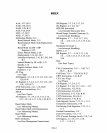
8086/8088
COMPATIBILITY CONSIDERATIONS
4.
Use Interrupt
16
for Numeric Exceptions.
Any
80287 system must use interrupt vector
16
for the numeric error interrupt.
If
an 8086/8087
or 8088/8087 system uses another vector for the 8087 interrupt, both vectors should point
at
the
numeric error interrupt handler.
5.
Numeric Exception Handlers Should allow Prefixes.
The saved
CS:IP value in the
NPX
environment save area
will
point at any leading prefixes before
an
ESC instruction. On 8086/8088 systems, this value points only at the ESC instruction.
6.
Do Not Attempt Undefined 8086/8088 Operations.
Instructions like
POP CS or MOV CS,op
will
either cause exception 6 (undefined opcode) or
perform a protection setup operation like LIDT
on
the 80286. Undefined bit encodings for bits
5-3
of the second byte of POP
MEM
or PUSH
MEM
will cause exception
13
on
the 80286.
7.
Place a Far
JMP
Instruction at FFFFOH.
After reset, CS:IP =
FOOO:FFFO
on
the 80286 (versus
FFFF:OOOO
on
the 8086/8088). This change
was made
to
allow sufficient code space
to
enter protected mode without reloading CS. Placing a
far
JMP
instruction at FFFFOH will avoid this difference. Note
that
the BOOTSTRAP option of
LOC86
will
automatically generate this jump instruction.
8.
Do
not Rely
on
the Value Written by
PUSH
SP.
The 80286 will push a different value
on
the stack for
PUSH
SP
than the 8086/8088.
If
the value
pushed
is
important, replace
PUSH
SP instructions with the following three instructions:
PUSH
BP
MOV BP,SP
XCHG
BP,[BP]
This code functions
as
the 8086/8088
PUSH
SP instruction
on
the 80286.
9.
Do
not Shift or Rotate by More than
31
Bits.
The
80286 masks all shift/rotate counts to the
low
5 bits. This MOD
32
operation limits the count
to
a maximum of
31
bits. With this change, the longest shift/rotate instruction
is
39
clocks. Without
this change, the longest shift/rotate instruction would be 264 clocks, which delays interrupt response
until the instruction completes execution.
10.
Do
not Duplicate Prefixes.
The
80286 sets an instruction length limit of
10
bytes. The only way to violate this limit
is
by
duplicating a prefix two or more times before an instruction. Exception 6 occurs if the instruction
length limit
is
violated. The 8086/8088 has
no
instruction length limit.
11.
Do not Rely
on
Odd 8086/8088
LOCK
Characteristics.
The LOCK prefix and its corresponding output signal should only be used
to
prevent other bus
masters from interrupting a data movement operation. The
80286 will always assert LOCK during
an XCHG instruction with memory (even if the LOCK prefix was not used). LOCK should only
be used with the XCHG,
MOV, MOVS, INS, and OUTS instructions.
The
80286
LOCK
signal will
not
go
active during an instruction prefetch.
12.
Do not Single Step External Interrupt Handlers.
The priority of the
80286 single step interrupt
is
different from that of the 8086/8088. This change
was
made
to
prevent an external interrupt from being single-stepped if it occurs while single stepping
through a program. The
80286 single step interrupt has higher priority than any external
interrupt.
The
80286 will still single step through an interrupt handler invoked by
INT
instructions or an
instruction exception.
C-2


















